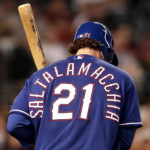The Mets Guide to Consistently Lose Ballgames
 Some teams manage to fall flat on their keisters just when they think they’re about to turn their season around. Part of it is misplaced hopes. Letting emotion get the better of their choices. And part of it is a lack of vision. Dare I say, stupidity? This is a story about how to consistently lose ballgames, Mets’ style.
Some teams manage to fall flat on their keisters just when they think they’re about to turn their season around. Part of it is misplaced hopes. Letting emotion get the better of their choices. And part of it is a lack of vision. Dare I say, stupidity? This is a story about how to consistently lose ballgames, Mets’ style.
Players of this Ilk
One of this year’s prime examples of how to craft a losing team is the New York Mets. Every game someone makes a key miscue or fails in the clutch. Or the team relies on players whose better days are behind them. Todd Frazier and his 1.1 WAR in 2019 are a perfect example. He’s a bench player on a good team or a starter on a bad team—like the Mets.
Had the Mets held onto Justin Turner when he was a Met between 2009 and 2013 (when his OPS+ increased each season from 29 in 2010 to 100 in 2013, skyrocketing upwards from there to as high as 155 as a member of the Los Angeles Dodgers), rather than releasing him for nothing, he would still look good at third for the Mets—especially his 3.8 WAR this season.
The Mets brought an outfielder in to begin the season, not necessarily to start, but to play against lefties. As a right-handed hitter with speed who played all three outfield positions and offered balance to a left-handed hitting outfield.
Why the Mets traded for a player of this ilk is the question.
Perhaps they traded for him because they hoped he was better than his dreadful numbers the few seasons before. Or perhaps it was just wishful thinking—a philosophy which characterizes the Mets approach to team-building.
While this player is not the reason they are playing .504 baseball after being swept by the Chicago Cubs on Thursday night and the Atlanta Braves over the weekend to complete a 3-6 home stand, this player was a symbol of wrong thinking. (He’s no longer with the Mets.)
This player was Keon Broxton. The Mets since traded him to Baltimore for international signing rights dollars, and then Baltimore released him. He was selected off waivers by the Seattle Mariners, for whom he is playing now.
Not to reiterate a point made in earlier columns, but GMs like Farhan Zaidi or Thad Levine would not have traded for Broxton. Perhaps that’s why the Giants are a better team today than earlier in the season and the Minnesota Twins are playing .617 baseball—leading the Cleveland Indians by 4.5 games in the AL Central.
New York Mets Signature Style
The Cubs-Mets series, which ended Thursday night, was a further example of the difference between a good team benefitting from effective management and a bad team suffering from inept leadership.
Not that the Cubs are the best team in the National League. They’re not. But their roster is laced with athleticism and skill. Athleticism and skills the Mets wish their previous GMs had packed their roster with.
Thursday night, the Cubs beat last year’s Cy Young Award winner, Jacob deGrom, who as usual pitched wonderfully with minimal run support and little room for error. A three-run home run later and deGrom was on the wrong side of a 4-1 score after six and a half innings. The game ended 4-1 and deGrom, despite throwing a one-hitter over six innings, was the loser.
The Mets looked futile at home plate and, as usual, their center fielder Juan Lagares had another oh-fer game, pinch-hit for by the equally light-hitting Luis Guillorme, who grounded out to end the game.
On the Mets’ side the utter futility of Juan Lagares in his four at-bats in the second game on Wednesday night stands out in stark relief. Had Lagares delivered even one or two of the six runners he stranded on base, the Mets might have come back all the way from an early 10-1 deficit and won the game. Even a productive out would have helped, but Lagares has disappointed the Mets offensively every season since he debuted in 2013 except one, 2014, when he managed a paltry OPS+ of 102. This is how to consistently lose ballgames, Mets’ style.
More Juan Lagares
Compare that to his OPS+ of 57 in 216 at-bats in 2019. His WAR is -0.9 this season. He is and has been a below-average offensive performer his entire career. Yet the Mets have stuck with him as though he is related to the Wilpons. That’s how to consistently lose ballgames, Mets’ style.
He’s not related to the Wilpons. But he’s earning $9 million of their dollars this season before he becomes a free agent after the season. So, he only seems like family?
Perhaps that’s why the Mets never tried to replace him. Settling instead for square pegs in round holes. Players like Brandon Nimmo, Michael Conforto, Yoenis Cespedes, Kirk Nieuwenhuis, Austin Jackson and Matt den Dekker, among others. None of who were true center fielders.
Perhaps that’s why Brodie Van Wagenen has not addressed center field this season and continued the recent Mets tradition of trying to win with substandard defenders in center. To his credit, Juan Lagares is a very good major league center fielder. But he is a defensive replacement. Not a platoon player. He’s not worth $9 million.
Lagares, in seven seasons, has a career OPS+ of 83. So during his time in the majors he has been 17 percent worse than the average major leaguer. His career WAR of 12.1 translates into a WAR of 1.72 per season. Not the kind of on-field production that wins many games. Yet the Mets have never traded for a bona fide center fielder.
Why? Are Juan Lagares and Keon Broxton the only center fielders available in all of baseball?
The Keon Broxton Solution
Brodie Van Wagenen brought in Keon Broxton to start the season. His brief 34-game tenure with the Mets was an abject failure, (an OPS+ of 2) unworthy of even a waiver pickup. So far, with three teams in 2019, Broxton has a -0.8 WAR. (The Mets seem to favor players with negative WARs.)
In five seasons, his career OPS+ has been 80, that’s 16 per season. In other words, he’s like a pitcher at the plate. Why did Van Wagenen trade three (admittedly third-rate) prospects to Milwaukee for him? What did he see?
Didn’t the Mets have an outfielder in their minor leagues worthy of a call-up? Or what about a Rule Five selection? There must have been one productive outfielder (or a shortstop who could be moved to the outfield?) somewhere in the minors they could have traded for.
Other Alternatives?
Mike Tauchman? Him of the 2.4 WAR and OPS+ of 130 so far in 235 at-bats in 2019 for the Yankees. He’s even occasionally played center field this season. Colorado traded him to the Yankees prior to the season for minor league lefty Philip Diehl who has put up an 18.00 ERA in 2 innings for Colorado in 2019.
Why couldn’t the Mets have made this trade? Wasn’t there one ineffective lefty they could have moved to make the deal?
Toronto traded Kevin Pillar to the Giants for three prospects. earlier this season. They could have just as easily traded him to the Mets who could have used the 92 OPS+ and 1.6 WAR he’s put up for the Giants in 486 at-bats this season. Much better production than Lagares and Broxton. However, Pillar came with a $5.8 million salary. The Mets prefer to pretend that Queens is like Kansas City, not seven miles from midtown Manhattan.
Keon Broxton is only earning $571,765 this season. Mike Tauchman is earning $557,000. There are values, and values. It was easy to find Keon Broxton on the scrap heap. Not as easy to find Mike Tauchman who required an effective scouting staff.
This is how professional major league teams improve their rosters. Carefully. They don’t jump at the chance to acquire the Keon Broxtons of the baseball world. But if they did, they would learn how to consistently lose ballgames, Mets’ style.
Unfortunately for Mets’ fans, the Mets are a losing organization. Who would you have rather had at the plate the last two games against the Cubs? Juan Lagares, who went 0-for-7. Or Kevin Pillar or Mike Tauchman? Even 1- or 2-for-7 might have made a difference.
What do you think, Brodie Van Wagenen?

























